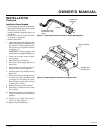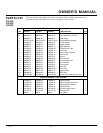
20
105192
UNVENTED PROPANE/LP GAS LOG HEATER
CLEANING AND
MAINTENANCE
WARNING: Turn off heater
and let cool before cleaning.
CAUTION: You must keep
control areas, burner, and circu-
lating air passageways of heater
clean. Inspect these areas of
heater before each use. Have
heater inspected yearly by a quali-
fied service person. Heater may
need more frequent cleaning due
to excessive lint from carpeting,
pet hair, bedding material, etc.
LOGS
• If you remove logs for cleaning, refer to
Installing Logs, page 14, to properly re-
place logs.
• Replace log(s) if broken or chipped
(dime-sized or larger).
MAIN BURNER
Periodically inspect all burner flame holes
with the heater running. All slotted burner
flame holes should be open with yellow
flame present. All round burner flame holes
should be open with a small blue flame
present. Some burner flame holes may be-
come blocked by debris or rust, with no
flame present. If so, turn off heater and let
cool. Remove blockage. Blocked burner
flame holes will create soot.
SERVICE HINTS
When Gas Pressure Is Too Low
• pilot will not stay lit
• burners will have delayed ignition
• heater will not produce specified heat
• propane/LP gas supply may be low
You may feel your gas pressure is too low.
If so, contact your local propane/LP gas
supplier.
TECHNICAL
SERVICE
You may have further questions about in-
stallation, operation, or troubleshooting. If
so, contact Fireplace Manufacturers
Incorporated’s Technical Service Depart-
ment at 1-866-672-6040.
You can also visit DESA International’s
Technical Service web site at
www.desatech.com.
Figure 23 - Injector Holder On Outlet
Burner Tube
Burner
Tube
Injector Holder
(May Be Brass
or Aluminum
Depending on
Model)
Primary Air Inlet
Holes (Shape of
Holes May Vary
by Model)
Figure 24 - Pilot Inlet Air Hole
Burner
Tube
Pilot
Assembly
Pilot Air
Inlet
Hole
Ports/Slots
CLEANING BURNER
INJECTOR HOLDER AND
PILOT AIR INLET HOLE
The primary air inlet holes allow the proper
amount of air to mix with the gas. This
provides a clean burning flame. Keep these
holes clear of dust, dirt, lint, and pet hair.
Clean these air inlet holes prior to each
heating season. Blocked air holes will create
soot. We recommend that you clean the unit
every three months during operation and
have heater inspected yearly by a qualified
service person.
We also recommend that you keep the burner
tube and pilot assembly clean and free of
dust and dirt. To clean these parts we recom-
mend using compressed air no greater than
30 PSI. Your local computer store, hard-
ware store, or home center may carry com-
pressed air in a can. You can use a vacuum
cleaner in the blow position. If using com-
pressed air in a can, please follow the direc-
tions on the can. If you don't follow direc-
tions on the can, you could damage the pilot
assembly.
1. Shut off the unit, including the pilot.
Allow the unit to cool for at least thirty
minutes.
2. Inspect burner, pilot, and primary air
inlet holes on injector holder for dust
and dirt (see Figure 22).
3. Blow air through the ports/slots and
holes in the burner.
4. Check the injector holder located at the
end of the burner tube again. Remove
any large particles of dust, dirt, lint, or
pet hair with a soft cloth or vacuum
cleaner nozzle.
5. Blow air into the primary air holes on
the injector holder.
6. In case any large clumps of dust have
now been pushed into the burner repeat
steps 3 and 4.
Clean the pilot assembly also. A yellow tip
on the pilot flame indicates dust and dirt in
the pilot assembly. There is a small pilot air
inlet hole about two inches from where the
pilot flame comes out of the pilot assembly
(see Figure 23). With the unit off, lightly
blow air through the air inlet hole. You may
blow through a drinking straw if compressed
air is not available.


















